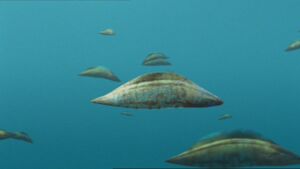Haikouichthys was an early ancestor of fish from the middle Cambrian period. It was one of the very first vertabrates on Earth, the forefather of reptiles, mammals, fish and humans.
Facts[]
Description[]
Haikouichthys is about 2.5 cm (1 inch) long and is narrower than Myllokunmingia, another putative chordate that comes from the same beds. The animal has a distinct head and tail. The head has at least six and perhaps nine probable gills. There are a number of segments (myomeres) with rear directed chevrons in the tail. There is probably a notochord, although only a short segment is preserved in the single known specimen. There is a prominent dorsal fin with fin radials similar, but not comparable, to those of hagfish and lampreys. The fin radials seem to angle "forward" toward the end thought on the basis of internal structures to be the head. This happens with a few modern fish but is an uncommon arrangement. There are 13 circular structures along the bottom that may be gonads, slime organs, or something else entirely.
Discovery[]
The holotype of Haikouichthys ercaicunensis was found in the Yuansshan member of the Qiongzhusi Formation in the 'Eoredlichia' Zone near Haikou at Ercaicun, Kunming City, Yunnan, China, hence its name "Haikou fish from Ercaicun". The fossil was recovered among the Chengjiang fauna, in one of a series of Lagerstätten sites where thousands of exquisitely preserved soft-bodied fossils have already been found. Following the discovery of the holotype, additional Lower Cambrian fossils of Haikouichthys ercaicunensis have been discovered.[1]
In the Walking with series[]
Walking with Monsters[]
Water Dwellers[]
A shoal of Haikouichthys was first seen in the background. Later, after a wounded Anomalocaris lost a fight, the shoal harassed and fed on the Anomalocaris whilst it was still alive. One later evolved in Cephalaspis.
Errors[]
- Haikouichthys' was seen evolving into Cephalaspis. Haikouichthys itself didn't evolve into Cephalaspis, another species of fish did.
External links[]
References[]
- ↑ en.wikipedia.org/wiki/Haikouichthys
|
